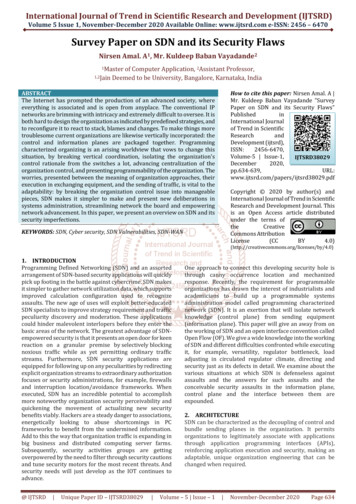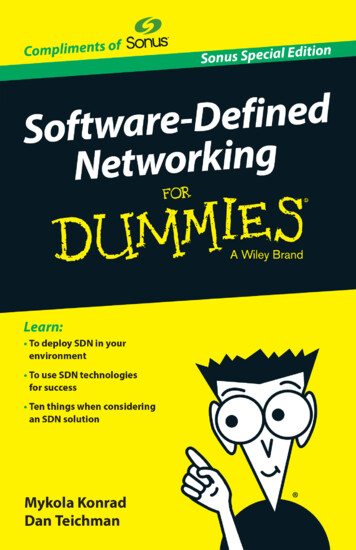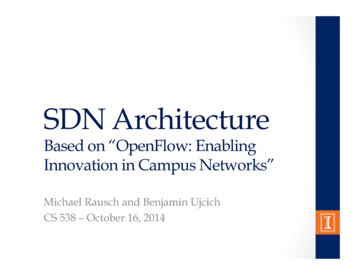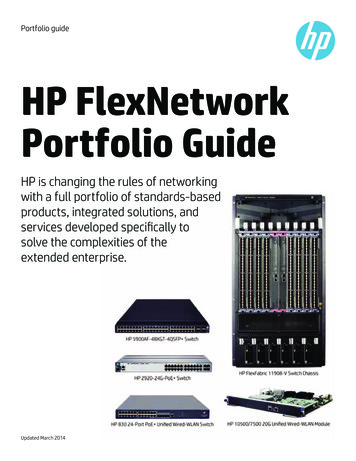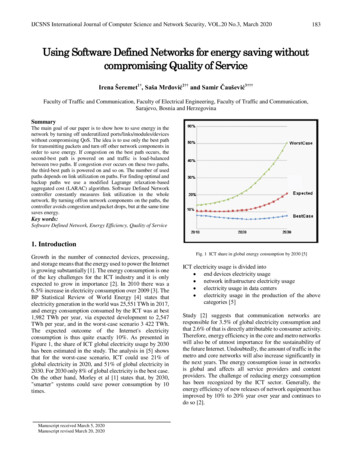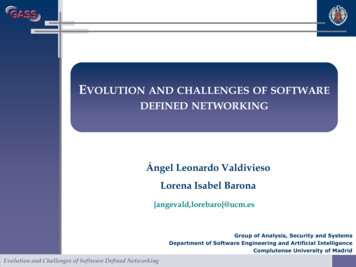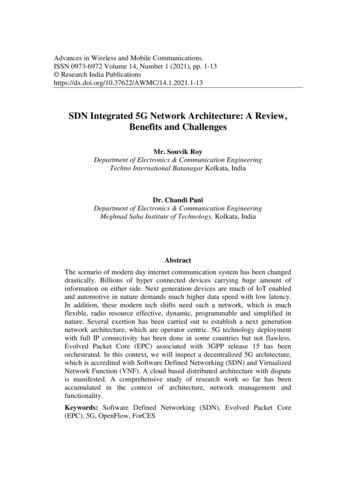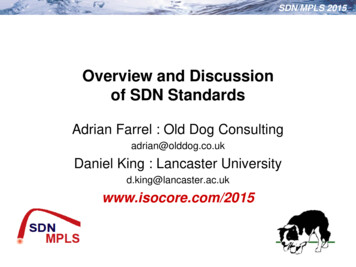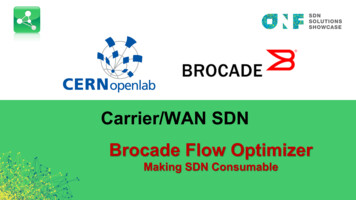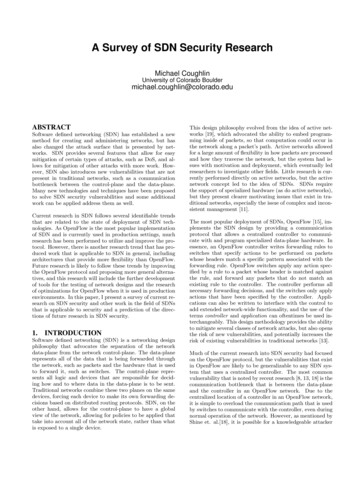
Transcription
A Survey of SDN Security ResearchMichael CoughlinUniversity of Colorado re defined networking (SDN) has established a newmethod for creating and administering networks, but hasalso changed the attack surface that is presented by networks. SDN provides several features that allow for easymitigation of certain types of attacks, such as DoS, and allows for mitigation of other attacks with more work. However, SDN also introduces new vulnerabilities that are notpresent in traditional networks, such as a communicationbottleneck between the control-plane and the data-plane.Many new technologies and techniques have been proposedto solve SDN security vulnerabilities and some additionalwork can be applied address them as well.Current research in SDN follows several identifiable trendsthat are related to the state of deployment of SDN technologies. As OpenFlow is the most popular implementationof SDN and is currently used in production settings, muchresearch has been performed to utilize and improve the protocol. However, there is another research trend that has produced work that is applicable to SDN in general, includingarchitectures that provide more flexibility than OpenFlow.Future research is likely to follow these trends by improvingthe OpenFlow protocol and proposing more general alternatives, and this research will include the further developmentof tools for the testing of network designs and the researchof optimizations for OpenFlow when it is used in productionenvironments. In this paper, I present a survey of current research on SDN security and other work in the field of SDNsthat is applicable to security and a prediction of the directions of future research in SDN security.1.INTRODUCTIONSoftware defined networking (SDN) is a networking designphilosophy that advocates the separation of the networkdata-plane from the network control-plane. The data-planerepresents all of the data that is being forwarded throughthe network, such as packets and the hardware that is usedto forward it, such as switches. The control-plane represents all logic and devices that are responsible for deciding how and to where data in the data-plane is to be sent.Traditional networks combine these two planes on the samedevices, forcing each device to make its own forwarding decisions based on distributed routing protocols. SDN, on theother hand, allows for the control-plane to have a globalview of the network, allowing for policies to be applied thattake into account all of the network state, rather than whatis exposed to a single device.This design philosophy evolved from the idea of active networks [19], which advocated the ability to embed programming inside of packets, so that computation could occur inthe network along a packet’s path. Active networks allowedfor a large amount of flexibility in how packets are processedand how they traverse the network, but the system had issues with motivation and deployment, which eventually ledresearchers to investigate other fields. Little research is currently performed directly on active networks, but the activenetwork concept led to the idea of SDNs. SDNs requirethe support of specialized hardware (as do active networks),but they present clearer motivating issues that exist in traditional networks, especially the issue of complex and inconsistent management [11].The most popular deployment of SDNs, OpenFlow [15], implements the SDN design by providing a communicationprotocol that allows a centralized controller to communicate with and program specialized data-plane hardware. Inessence, an OpenFlow controller writes forwarding rules toswitches that specify actions to be performed on packetswhose headers match a specific pattern associated with theforwarding rule. OpenFlow switches apply any action specified by a rule to a packet whose header is matched againstthe rule, and forward any packets that do not match anexisting rule to the controller. The controller performs allnecessary forwarding decisions, and the switches only applyactions that have been specified by the controller. Applications can also be written to interface with the control toadd extended network-wide functionality, and the use of theterms controller and application can oftentimes be used interchangeably. This design methodology provides the abilityto mitigate several classes of network attacks, but also opensthe risk of new vulnerabilities, and potentially increases therisk of existing vulnerabilities in traditional networks [13].Much of the current research into SDN security had focusedon the OpenFlow protocol, but the vulnerabilities that existin OpenFlow are likely to be generalizable to any SDN system that uses a centralized controller. The most commonvulnerability that is noted by recent research [8, 13, 18] is thecommunication bottleneck that is between the data-planeand the controller in an OpenFlow network. Due to thecentralized location of a controller in an OpenFlow network,it is simple to overload the communication path that is usedby switches to communicate with the controller, even duringnormal operation of the network. However, as mentioned byShine et. al.[18], it is possible for a knowledgeable attacker
to craft packets that will cause a standard OpenFlow network to quickly saturate the control communication channel,leading to some form of Denial of Service (DoS) attack in thenetwork, possibly by preventing access to the controller, andat least preventing the creation of new flow entries. This issue can also manifest as a failure of the controller, and therehas been much research on how to make the controller morefault tolerant [20, 9]. This work generally attempts to create a distributed but logically centralized controller, and thefault tolerant properties of these solutions would make themmore resistant to a DoS attack.Other recent work in SDN security research has sought toleverage the programmability and visibility that is providedby SDN in order to increase security against traditional attacks [17, 16, 14]. These solutions are not solely restrictedto OpenFlow, but they do take advantage of SDN tenets.These technologies allow for the implementation of common mitigation strategies, including the use of middleboxes,detection algorithms and classification algorithms that areused to secure traditional networks. These solutions are useful for ensuring that SDNs are not vulnerable to known network susceptible, especially attacks targeted at hosts.In this paper, I present a review of the current researchinto SDN security technologies, as well as some technologiesthat are directly applicable to SDN security. I also presenta short overview of the evolution of SDN and a predictionof future SDN security research. Current security researchin the field of SDN can be separated into OpenFlow-specificand general solutions, and specific to OpenFlow, can be splitinto research on protocol-specific and traditional networkvulnerabilities.Finally, I present an analysis of the trends in SDN security research and a prediction of the paths that future research will follow. Current research has placed a large focuson addressing the shortcomings of OpenFlow and there hasalso been an emphasis on the creation of network designsthat incorporate flexibility that OpenFlow is not capable of.In terms of security, research trends show that the benefitsprovided by new network designs oftentimes introduce newvulnerabilities in the very features that differentiate themfrom the existing systems, as is illustrated by the OpenFlowcontrol-plane communication bottleneck. To summarize mypredictions that are detailed in Section 6, I predict that research will continue to be performed that attempts to address the shortcomings of OpenFlow due to its adoption byindustry, including the creation of simpler development toolsand the optimization and change of several of the protocol’sfeatures. I also predict that tools used to test SDN alternatives to OpenFlow, such as software switches and field programmable gate arrays (FPGAs), will be improved so thatOpenFlow alternatives and hardware-side improvements toOpenFlow can be tested.This paper continues in Section 2 by first presenting a briefoverview of the evolution of SDN. In Section 3, I reviewseveral recent works in SDN security and how these specific works relate to different aspects of SDNs. In Section4, I present a more detailed discussion of OpenFlow specificsecurity technologies, and in Section 5, I detail the remaining technologies that are applicable to SDN in general. InSection 6, I present an analysis of trends in SDN securityresearch and predixt how SDN research will progress in thefuture, and I conclude the paper in Section 7.2.EVOLUTION OF SDNSoftware defined networking has evolved from several different research tracks, starting with research into active networks. Although some of these tracks were unsuccessful,they were all motivated by the challenges faced by managing a growing Internet and the desire to have more flexibleand programmable networks.2.1Active NetworksResearch into SDN was first motivated by the field of active networks. Active networking provided an ability toembed computation into packets and network devices, allowing for the computation to occur inside the network asa packet traveled through the network [19]. An illustrationof the operation of an active network is shown in Figure 1.This system provided a SDN-like interface to programmersand allowed for interesting classes of applications, such asthe ability to modify packet headers at different points in apacket’s flow or implement common network functions, including firewalls or proxies, inside of the network withoutthe need for extra hardware. However, active networkingintroduced some fundamental challenges that proved to bedifficult to solve.The largest of these issues was a lack of a single clear motivation for deployment. Although many applications for thetechnology could be described, none of the them provided acompelling reason for deployment of the system [10]. Without this reason, network operators had no incentive to deploy the extensive hardware upgrades that would have beenrequired to support the system.2.2Early SDNActive networks, despite their limitations, represent a design thats attempts to provide the flexibility that currentSDN strategies strive for. Learning from the motivationalissues that prevented the adoption of active networks, researchers focused on narrower and more clearly defined problems, which led to a focus on a separation between the control plane and the data plane. This focus was promptedby the increase in traffic volumes as the Internet grew insize, leading to network administrators to search for a newcontrol interface for their networks. Early technologies attempted different methods of creating a separation betweenthe control and data planes [10]. However, many of thesetechnologies proposed the use of standard APIs for control ofthe data-plane, while leaving the operation of the data-planeessentially unchanged. These designs left little incentive foradoption by hardware vendors [10], as they would have allowed new competitors access to their products.New technologies were soon proposed that created cleanslate designs for centralized control of networks [11, 7] . Suchtechnologies allowed for entirely new methods for controlwhile still using existing protocols in the data-plane, such asIP, ARP, TCP and others. In addition, these designs allowedfor easier deployment as they could be deployed alongside existing traditional networks. In particular, the work proposed
(a) An active network transmitting data with active contents. Thedata will cause computation to occur in the network based on itscontents.(b) An active network that is transmitting non-active data. Thepacket is transferred as if the network is not active.Figure 1: Two examples of active network operation. Red elements represent network elements and data that are activenetwork enabled.by Ethane included a full-scale deployment of an SDN system that supported end hosts and existing network devicesunmodified, which provided clear example of a functioningsystem. These works proved to be the first attempts at SDNdesigns, and led to the design of the OpenFlow protocol [10].2.3OpenFlowEarly work in SDN research encountered a basic issue of deployment scale, which led to different trade-offs between thelevel of programmability in the network and the ease of deployment. However, work such as Ethane proved that SDNnetworks were deployable, and campus networks were oftentimes used to implement new network designs, along withtools like Emulab, PlanetLab and the GENI project[10]. TheOpenFlow protocol was designed to be deployed inside ofthese networks, with a trade-off designed to ease distribution while still providing network programmability.The protocol allows for a centralized controller to controlspecial OpenFlow-enabled devices using a specific communication protocol, but the messages inside of the data-planeare transmitted using existing protocols (IP, TCP, etc.).Furthermore, existing traditional network devices can beused alongside OpenFlow enabled hardware due to the support of existing network protocols. The OpenFlow controllercontrols OpenFlow-enabled devices by writing instructionsdirectly to device forwarding tables, which act on information encoded in protocol headers (IP addresses, TCP ports)in order to determine the correct forwarding action. Theprotocol defines a number of actions that can be performedon a packet, and when a packet is received by an OpenFlowenabled device, the device checks the flow table, which ispopulated with rules sent from the controller, for a matchfor the packet. If any of the defined rules match informationin the packet header, then the rule’s actions are applied tothe packet. Some actions that are defined by the protocolinclude actions to forward, drop, or modify a packet, andthe protocol allows for devices to match rules against theheaders of packets for most existing network protocols.The OpenFlow protocol was initially designed for deployment on campus networks, but as the utility of the protocolwas demonstrated, hardware vendor interest increased. Inaddition, the protocol began to see deployment in datacenters, and along with the promotion of the protocol by itsdevelopers, hardware vendors began to create network devices that have hardware support for the protocol. Workon software switches, such as Open vSwitch [1] allowed forresearchers to quickly create new applications, and then usevendor hardware to deploy them.With the data-plane provided by both software and hardware switches, the door was opened for the development ofcontrol-plane architecture. There have been many controllerarchitectures proposed, such as NOX, Floodlight, POX, Ryuand others, and all of these are capable of communicatingto switches using the OpenFlow protocol. In addition, thesearchitectures do not need to be run on specialized hardware,allowing for commodity hardware to be used to implementcontrollers.Despite the combined support for OpenFlow by both theresearch and industry communities, it should be noted thatOpenFlow is not synonymous with SDN. OpenFlow is currently the most popular implementation of SDN, but otherimplementations could exist, such as private designs fromindustry entities like Cisco, Microsoft or Google. It shouldalso be noted that OpenFlow is not a perfect solution. Research has identified several security issues in the protocol,which are detailed in Section 4. The protocol itself has alsoseen difficulties in deployment of new updates to the protocolspecification. Only the first protocol specification, version1.0, is commonly supported by vendors, despite the largeamount of community support, but the most recent specification has gone through several revisions [2]. Adoptionrate is much slower than other hardware protocols, such asWiFi.3.SURVEY OF SDN SECURITYFor this survey of current SDN research, I discuss elevendistinct works that have a direct bearing on SDN security.Some of these works are historical, but they serve to illustrate the trend of security research during the developmentof SDN. Security research in active networks, in particular,
Figure 2: Relation between different papers that address SDNwas not a priority, which may help to explain some of thesecurity issues that have been noted in modern SDN. Anillustration of how the papers discussed in this review relateto different SDN elements is shown if Figure 2. Each numbered paper that is defined in the figure is listed below, aswell as in the description of each paper in this section. Thework presented by Tennenhouse, et. al. is not indicated onthis figure, as this figure specifically list SDN technologiesbased of the design paradigm presented by Greenberg, et.al. and discussed in Section 3.1.2.5. Enabling Fast, Dynamic Network Processing withclickOS [14]Papers indicated in Figure 29. Revisiting Traffic Anomaly Detection using SoftwareDefined Networking [16]1. Towards an Elastic and Distributed SDN Controller [9]2. Kandoo : A Framework for Efficient and Scalable Offloading of Control Applications [20]3. DevoFlow: Scaling Flow Management for High-Performance Networks [8]4. AVANT-GUARD: Scalable and Vigilant Switch FlowManagement in Software-Defined Networks [18]6. Towards Secure and Dependable Software-Defined Networks [13]7. Public Review for A Clean Slate 4D Approach to Network Control and Management [11]8. Programming Protocol-Independent Packet Processors[6]10. FRESCO: Modular Composable Security Services forSoftware-Defined Networks [17]3.1Early SDN ResearchSoftware defined networking research can trace its roots toactive networking and research into 4D architectures, as presented in [11, 19] and discussed above. These two works,in particular, are representative works of the early researchin SDN-related fields. Although security was not the focus
of these two works, several security considerations are presented.3.1.1Active NetworksThe work presented by Tennenhouse, et. al. is a survey ofactive network that existed at the time of publication, 1997.In this survey, two approaches to active network researchare defined: a discrete approach, by using programmablenetwork switches that act to data packets and packets containing code differently; and an integrated approach, by encapsulating all data inside of a program packet, which wouldrequire network hardware to perform computation on eachpacket. The paper also presents strategies for interoperability between these two design philosophies, including differentprogramming language choices and use of common primitives and encoding schemes to ensure interoperability. Thepaper concludes with a list of current research topics in active networking from various institutions. It should be notedthat there are many projects listed in this survey, but verylittle work was done on related projects by these institutionspast the year 2000.In this particular work, the researchers present a single security consideration of active networks for future research.The authors present active networks as a simpler platform toimplement per-user authentication in the network, as compared to methods that existed at the time. As active networks allow for computation to be performed in the network,it was a logical extension to propose authentication in thenetwork. However, this work does propose an implementation of such an authentication mechanism. The paper doeshighlight research performed at the University of Pennsylvania on the SwitchWare project [3], which had a direct focuson security. However, work on the SwitchWare project effectively ceased in 1999.3.1.2The 4D ProjectThe second work, from Greenberg, et. al., is a publication ofa review of the original work, “A Clean Slate 4D Approachto Network Control and Management”. The original workadvocated the creation of networks based on four planes,the decision, dissemination, discovery and data planes. Thiswork follows a trend at the time to create network designsthat separate the control-plane from the data-plane, whichwas a more focused research problem then the architectures proposed by active networks. The separation of thecontrol- and data-planes provided a set of well-defined benefits, included a much-simplified administration interface,which would be beneficial to network operators faced withthe ever-increasing size of the Internet.The four planes presented by the 4D approach perform thisseparation by placing the control functionality into the decision plane and using the dissemination plane to communicate between the decision and data planes. The discovery plane is used by the decision plane in order to createa network wide view of all connected devices. By providing a network wide view to a separate control plane, theauthors present the 4D approach as having better potentialfor simple implementations of network-wide security policies, as the decision plane has the ability to place securitymeasures wherever is necessary in the network.However, the 4D system was a theoretical design that wasnot implemented for the paper. In addition, the authors noteseveral challenges to the architecture, including a number ofinherent security issues in the system that do not exist intraditional networks. These security issues, especially thatof attacks on the centralized decision plane, are still a topicof SDN security research today.3.2Recent SDN ResearchRecent research into SDN security follows two specific tracks,that of OpenFlow specific research, and general SDN research. As OpenFlow is the most prominent SDN deployment, there is great interest in mitigating security problemsin the protocol, as it is used in many production settings.However, other security research in general SDN strategiesallow for progress towards new protocols beyond OpenFlow.3.2.1General SDN SecurityOpenFlow, despite its popularity, is not the only method ofimplementing SDNs. There are many limitations of OpenFlow, with the limitations relating to security detailed inSection 4. The work presented in this section lists researchthat has security applications towards SDNs in general, incontrast to those limited to the OpenFlow specification.Programming Protocol-Independent Packet Processors.The work presented by Bosshart et. al. advocates the creation of switch hardware that can support any arbitrary protocol using a parser and a series of match-action processors[6]. This work is motivated by the ability of OpenFlowenabled hardware to match rules to packets based on different header fields in existing protocols, which allows for rulesto be to be enacted on any possible permutations of thesefields. However, this work is also motivated by the fact thatOpenFlow can only be perform match-actions on protocolsthat are supported by the specification, such TCP or IP,rather than any arbitrary protocol that a developer desiresto support.This work proposes a method to match rules to header fieldsthat are defined by the programmer, which allows the system to support new protocols that have headers that aredifferently sized then existing protocols. In addition, thesystem advocates the use of a parser that reads programsthat are written in the domain-specific language provided bythe authors of the paper, which can be compiled to varioushardware platforms. This allows for various different hardware implementations to be supported so long as a compilercan be written for each platform. This ability has severalimplications for creation of new security measures, which isexplored further in Section 5.ClickOS. The work presented by Martins, et. al. is amethod for creating virtualized middleboxes that are capable of operating at line rate [14]. This work is motivated bythe Click Modular Router [12], which allows for the creationof varied packet processing datapaths that can implementvarious network functions. The researchers note that Clickcan be used to implement middleboxes in hardware, but theClick software is only implemented inside Linux operating
systems, which have a very high system footprint comparedto the functionality that is created by a middlebox implemented in Click. The researchers instead use MiniOS, a minimalistic operating system provided by the Xen hypervisor[4], and run the Click software inside of instances of this operating system. By using MiniOS, the researchers are ableto create new virtual machine instances very rapidly, witheach potentially implementing different middlebox functionality. This system presents software-defined middleboxesand presents several interesting security opportunities fordifferent SDN technologies, as is discussed in Section 5.3.2.2OpenFlow SecurityAs previously stated, the OpenFlow protocol is the deployment of SDN that has received the largest amount of support from the research community and industry. Due tothe popularity of the protocol, security issues that were notaddressed by the original specification are now priorities offocus, as the protocol is being used in production systems.Kreutz et. al. present in [13] a list of security vulnerabilities that exist in SDNs, especially the OpenFlow standard.The authors of this paper recognize that many of these vulnerabilities are not unique to SDNs, but these vulnerabilities are oftentimes changes and sometimes exacerbated inSDNs. The authors also present several mitigation strategiesfor these vulnerabilities that the selected research, detailedbelow, can be seen attempting to implement. The specificthreat vectors detailed in[13] are listed in Section 4.Towards an Elastic Distributed SDN Controller. In thiswork, Dixit et. al. present a distributed SDN controllerthat is compatible with OpenFlow [9]. This work makessignificant use of OpenFlow specific mechanisms, especiallyspecific OpenFlow switch management functions. The architecture allows for switches to be migrated between different controllers, and for a pool of available controllers tobe resized based on the demand seen in the network. Thiswork is differentiated from others in its use of a distributeddata store to store state about the network, and its safetyproperties that are ensured by the switch migration protocol. This work, along with Kandoo (detailed below), andother distributed controllers, can help to mitigate certainclasses of attacks, such as DoS attacks on the control plane,as explained in Section 4. However, the intention of thistechnology, along with other distributed controllers, is toincrease fault-tolerance and scalability of the control-plane,rather than to address security issues.Kandoo. In this work, Yeganeh and Ganjali present another distributed controller compatible with OpenFlow, whichdiffers from other work in its use of a controller hierarchy[20]. The authors present Kandoo as a system of controllersthat establish a hierarchical structure of responsibly, withonly the controllers at the top of the hierarchy having responsibly for the entire network. Controllers that exist lowerin the hierarchy are responsible only for local decisions, anddefer any decisions outside of their scope to the next level,just as the data-plane forwards all decisions to the controlplane. The authors only describe a low-level hierarchy witha local and global layer, but they claim that the system canbe extended to larger hierarchies if necessary. This systemis also useful for defenses against certain types of attack onthe control-plane, but its attack surface and response aredifferent than those presented by [9]. It should be notedthat security was not one of the primary goals of this work.DevoFlow. In this work, Curtis et. al. detail several shortcomings of the OpenFlow protocol that degrade its performance in high-performance networks, and then present anarchitecture for a protocol similar to OpenFlow that addresses these shortcomings [8]. The problems noted in OpenFlow by the authors are related to the fact that the controland data-planes must communicate in order to gather information about flows due to their separation. In smaller-scalenetworks, this communication is tolerable, but in higherperformance networks, the amount of communication canseriously degrade the performance of the network, which isnot just a performance issue, but also a potential securityrisk. The architecture presented by the authors returns adegree of responsibility to network devices to make local decisions, such as making quick routing decisions, and allowsfor more efficient collection of statistics in order to reducecommunication. In this architecture, the control-plane isonly consulted for unknown flows and flows that have beendesignated for specific traffic engineering goals, such as quality of service (QoS). This is another attempt at reducing theload on the control plane, similar to the previous two works.However, security considerations were made by the authorsduring the design of the system.AVANT-GUARD. In this work, Shin et. al. present a system that is directly focused on security vulnerabilities thatexist in OpenFlow [18]. The system is motivated by twospecific vulnerabilities in the protocol, namely the bottleneck in control-plane and data-plane communication andthe slow response rate of the controller to changes in thedata-plane. These vulnerabilities are an inherent flaw inthe separation of the data- and control-planes, as the controller has to initiate communication to interact with thedata-plane, and therefore experiences an unavoidable delay.The researchers propose two mechanisms for the OpenFlowprotocol in order to address these issues, which are implemented in the data-plane. The first of these mechanismsis the addition of an ability for network devices to directlyrespond to TCP connection requests and to filter out illicitconnections using SYN cookies [5] and a special TCP handshake procedure. In this method, the n
Other recent work in SDN security research has sought to leverage the programmability and visibility that is provided by SDN in order to increase security against traditional at-tacks [17, 16, 14]. These solutions are not solely restricted to OpenFlow, but they do take advantage of SDN tenets. These technologies allow for the implementation of com-
